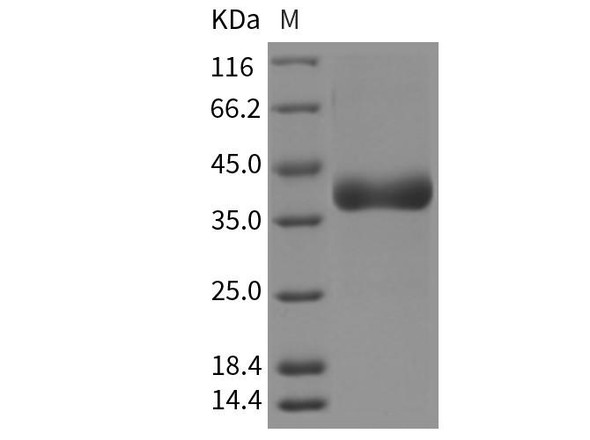Description
Recombinant Human Cathepsin B/CTSB Protein (His Tag)
| Background: | Cathepsin B is an enzymatic protein belonging to the peptidase (or protease) families. The protein encoded by this gene is a lysosomal cysteine protease composed of a dimer of disulfide-linked heavy and light chains, both produced from a single protein precursor. It is a member of the peptidase C1 family. At least five transcript variants encoding the same protein have been found for this gene. Cystatin-B / CSTB is an intracellular thiol proteinase inhibitor. Tightly binding reversible inhibitor of cathepsins L, H and B. Cystatin-B / CSTB is able to form a dimer stabilized by noncovalent forces, inhibiting papain and cathepsins l, h and b. Cystatin-B / CSTB is also thought to play a role in protecting against the proteases leaking from lysosomes |
| Name: | Recombinant Human Cathepsin B/CTSB Protein (His Tag) |
| Size: | 10µg |
| Assay Genie SKU: | RPES4612 |
| Synonyms: | Cathepsin B; APP Secretase; APPS; Cathepsin B1; CTSB; CPSB |
| Species: | Human |
| Expression host: | Human Cells |
| Sequence: | Arg18-Ile339 |
| Accession: | P07858 |
| Mol Mass: | 36.9 kDa |
| AP Mol Mass: | 40 kDa |
| Tag: | C-6His |
| Purity: | > 95 % as determined by reducing SDS-PAGE. |
| Endotoxin: | < 1.0 EU per µg as determined by the LAL method. |
| Storage: | Store at < -20°C, stable for 6 months. Please minimize freeze-thaw cycles. |
| Shipping: | This product is provided as liquid. It is shipped at frozen temperature with blue ice/gel packs.Upon receipt; store it immediately at<-20°C. |
| Formulation: | Supplied as a 0.2 um filtered solution of 20mM Tris-HCl, 150mM NaCl, pH 8.0. |
| Reconstitution: | Please refer to the printed manual for detailed information. |
| UniProt Protein Function: | CTSB: Thiol protease which is believed to participate in intracellular degradation and turnover of proteins. Has also been implicated in tumor invasion and metastasis. Dimer of a heavy chain and a light chain cross-linked by a disulfide bond. Interacts with SRPX2. Belongs to the peptidase C1 family. |
| UniProt Protein Details: | Protein type:Motility/polarity/chemotaxis; Protease; Autophagy; EC 3.4.22.1 Chromosomal Location of Human Ortholog: 8p22 Cellular Component: apical plasma membrane; caveola; external side of plasma membrane; extracellular region; extracellular space; intracellular; intracellular membrane-bound organelle; lysosome; melanosome; mitochondrion; nucleolus; perinuclear region of cytoplasm; sarcolemma Molecular Function:collagen binding; cysteine-type endopeptidase activity; cysteine-type peptidase activity; kininogen binding; peptidase activity; peptide binding; protein binding; protein self-association; proteoglycan binding Biological Process: autophagy; collagen catabolic process; decidualization; entry of virus into host cell; epithelial cell differentiation; extracellular matrix disassembly; extracellular matrix organization and biogenesis; innate immune response; proteolysis; proteolysis involved in cellular protein catabolic process; regulation of apoptosis; regulation of catalytic activity; response to amine stimulus; response to ethanol; response to glucose stimulus; response to organic cyclic substance; response to peptide hormone stimulus; response to wounding; skeletal muscle development; spermatogenesis; toll-like receptor signaling pathway |
| NCBI Summary: | This gene encodes a member of the C1 family of peptidases. Alternative splicing of this gene results in multiple transcript variants. At least one of these variants encodes a preproprotein that is proteolytically processed to generate multiple protein products. These products include the cathepsin B light and heavy chains, which can dimerize to form the double chain form of the enzyme. This enzyme is a lysosomal cysteine protease with both endopeptidase and exopeptidase activity that may play a role in protein turnover. It is also known as amyloid precursor protein secretase and is involved in the proteolytic processing of amyloid precursor protein (APP). Incomplete proteolytic processing of APP has been suggested to be a causative factor in Alzheimer's disease, the most common cause of dementia. Overexpression of the encoded protein has been associated with esophageal adenocarcinoma and other tumors. Multiple pseudogenes of this gene have been identified. [provided by RefSeq, Nov 2015] |
| UniProt Code: | P07858 |
| NCBI GenInfo Identifier: | 68067549 |
| NCBI Gene ID: | 1508 |
| NCBI Accession: | P07858.3 |
| UniProt Secondary Accession: | P07858,Q503A6, Q96D87, B3KQR5, B3KRR5, |
| UniProt Related Accession: | P07858 |
| Molecular Weight: | 37,822 Da |
| NCBI Full Name: | Cathepsin B |
| NCBI Synonym Full Names: | cathepsin B |
| NCBI Official Symbol: | CTSB |
| NCBI Official Synonym Symbols: | APPS; CPSB |
| NCBI Protein Information: | cathepsin B |
| UniProt Protein Name: | Cathepsin B |
| UniProt Synonym Protein Names: | APP secretase; APPS |
| Protein Family: | Cathepsin |
| UniProt Gene Name: | CTSB |
| UniProt Entry Name: | CATB_HUMAN |










